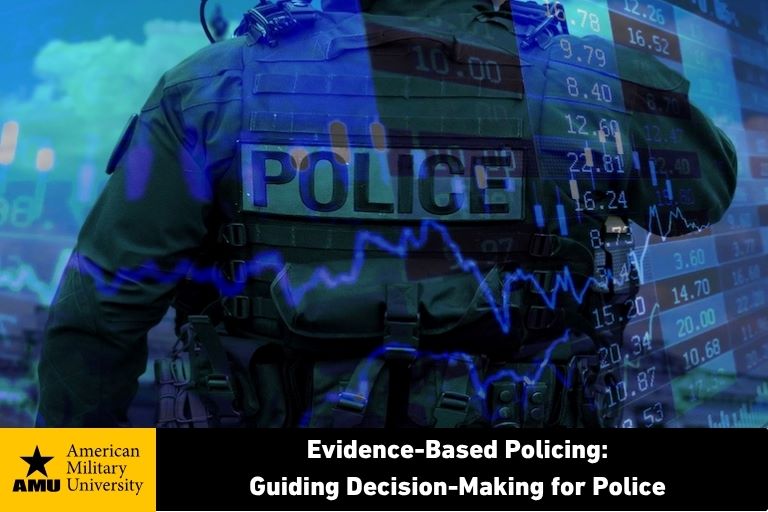By Dr. Matthew Loux and Bryce Loux | 11/03/2025

Modern police officers have to deal with rising expectations from the community, as well as transparency and accountability. Policing strategies based solely on an officer’s experience, police organizational culture, or gut instinct are no longer enough.
Many police organizations are adopting evidence-based policing (EBP), which involves the use of research, data, and evaluation. However, evidence-based policing does not eliminate an officer’s judgment. Instead, it helps to ensure greater effectiveness and resource optimization.
The idea of evidence-based policing began in the late 1990s. Criminologist Lawrence Sherman observed that policing, like all other professional practices, should be based on science. Ideally, the police should apply systematic evidence to determine the most effective strategies to prevent crime.
The development of evidence-based policing (EBP) fundamentally changed the way law enforcement agencies operated and shifted to the use of scientifically driven methods. Some important aspects of evidence-based policing include:
- Police activities and policies should be informed by current scientific literature to help implement proper practices.
- Data should guide decision-making, which can help to improve policing and prevent crime.
- Crime analysis, predictive policing, and performance metrics should be used to guide tactical deployment.
- Police agencies should conduct evaluations of their strategies on a routine basis to determine any barriers that inhibit success.
- Police and academics should work together on research to help asses and fill the gaps in empirical research.
Why Are Evidence-Based Policing Strategies Useful?
Evidence-based policing strategies have proven their worth for police officers and police leaders. The advantages include:
- Enhanced crime reduction – Certain policing programs, such as hotspot policing, help to decrease crime and improve public safety.
- Improved resource allocation – The limited amount of police budgets necessitates the efficient allocation of police time and resources. Evidence-based policing guarantees the allocation of police departments' time, resources, and effort toward more productive strategies designed to improve public safety.
- Better use of police technology – The efficacy of predictive analytics, body-worn cameras, and real-time crime centers can be evaluated using evidence-based practice methodologies.
- Improved public trust, accountability, and legitimacy – With evidence-based policing, public accountability is more easily achieved, especially when that type of policing is based on research evidence. Citizens are more likely to be committed to policies and interventions when processes and outcomes are proven to be efficient and just. Police compliance, collaboration, and trust are gained when citizens are treated with fairness and transparency.
- Increased professionalism – Police practitioners are more likely to act in a professional manner when evidence is the driving force behind policy and practice.
By conducting data analyses, officers and agencies can identify the root causes of chronic issues and develop focused problem-solving strategies to improve public safety. Evidence-based policing strengthens problem-oriented policing by scientifically validating police interventions.
The Challenges of Evidence-Based Policing
Although evidence-based policing is being adopted in areas such as the United States, the United Kingdom, and other locations, it has some challenges to overcome. These challenges include:
- Cultural resistance – Some police officers may distrust the influence of academics in evidence-based research and object to the implementation of evidence-based policing. However, this resistance can be mitigated through various tactics, such as buy-in from leadership, communication, and appropriate training within police departments.
- Resource limitations – Smaller police departments are particularly impacted by the lack of research capacity. As a result, their ability to conduct robust studies and evaluate their effectiveness as a crime deterrent is hindered by other priorities.
- Social problems – Social problems are complex to assess and have no easy answers. The demographics or culture of a community may limit the effectiveness of intervention efforts by law enforcement agencies.
- Regular updates – Over time, evidence changes policing practices. As a result, police agencies and other stakeholders must be in a constant state of adaptation in regard to evidence-based crime policies. Police departments and police leaders should work with researchers to continually monitor predictive policing practices and aim to narrow any gaps in research or testing.
Privacy and Data Use
Predictive analytics and today’s surveillance technologies involve ethical controversies concerning areas such as:
- Privacy
- Bias
- Fairness
- Accountability
Predictive analytics requires regular data collection on individuals. Online searches, ecommerce purchases, and GPS locations can help forecast an individual’s next moves.
However, most people do not enjoy this level of surveillance and data collection. In fact, most of their data is shared with or sold to third parties without consent.
This lack of consent has led to the erosion of personal privacy. Being constantly monitored can change how people behave, which is related to the panopticon effect.
However, the improved efficiency and safety created by evidence-based policing, as well as improved insights through data-driven assessments, cannot be ignored.
Algorithmic Bias and Inequality
Predictive analytics is arguably the most ethically challenging function for any data-driven organization. A bias in algorithms can be caused by trained analytical models working off historical data and incorporating social inequities.
For example, predictive policing algorithms trained on arrest records may target over-policed and over-arrested communities. That continues to deepen racial and socioeconomic inequalities.
In addition, relying solely on algorithms, raises the risk of unchecked policing, wrongful data-driven profiling, and the erosion of due process protections. Based on a mere algorithmic assessment, someone may be labeled as a potential offender and subjected to policing.
Similarly, facial recognition systems have been shown to have more errors in recognizing women and people of color. In return, that could increase the risk of wrongful suspicion and led to the wrong person being arrested for a crime.
Future Directions in Evidence-Based Policing
Future evidence-based policing practice will be built around crime evidence and will also increase the focus on the legitimacy, trust, and justice of governance in diverse communities. Possible future improvements will include:
- More technology and big data – There will be more advanced analytics and artificial intelligence tools, which will lead to a more in-depth understanding of crime and patterns. However, high levels of regulation will be necessary to prevent bias.
- Learning across borders – Global organizations such as the Society of Evidence-Based Policing in the U.K. and Australia will increase opportunities for law enforcement officers to learn across borders.
- Increased inclusion in training and policy – There will be more integration of the principles of evidence-based policing in police academies and leadership training programs.
Evidence-based policing faces many challenges. However, it can decrease crime rates and meet the changing demands of communities.
The Bachelor of Science in Criminal Justice at AMU
For aspiring law enforcement professionals, American Military University (AMU) provides an online Bachelor of Science in Criminal Justice. In this degree program, adult learners will study criminal profiling, crime analysis, and criminal investigation. Other courses involve digital forensics, ethics in criminal justice, and criminal law.
For more information, visit AMU’s criminal justice degree program page.
Note: This degree program is not designed to meet the educational requirements for professional licensure or certification in any country, state, province or other jurisdiction. This program has not been approved by any state professional licensing body and does not lead to any state-issued professional licensure.
Dr. Matthew Loux is a criminal justice faculty member for the School of Security and Global Studies at American Military University. He holds a bachelor’s degree in criminal justice and a master’s degree in criminal justice administration from the University of Central Missouri State, a doctoral degree in management from Colorado Technical University, and a Ph.D. in educational leadership and administration from Aspen University.
Dr. Loux has been in law enforcement for more than 30 years. He has a background in fraud and criminal investigation, as well as hospital, school, and network security. Dr. Loux has researched and studied law enforcement and security best practices for the past 10 years.
Bryce Loux is an alumnus of American Public University. He holds a bachelor’s degree in fire science with a minor in criminal justice. Bryce is currently a student success coach.

